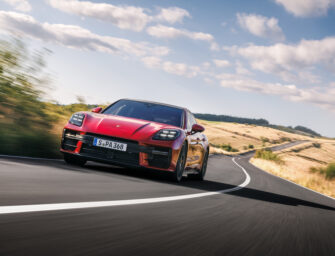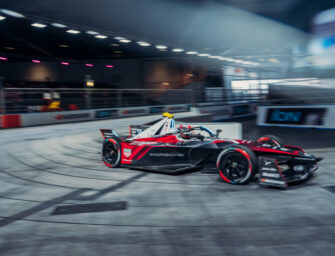Formula One ace David Coulthard, daredevil Felix Baumgartner, Paris-Dakar champion Marc Coma, and US motorcyclist Ricky Johnson will be among the 35 Catcher Car drivers chasing tens of thousands of runners in the second Wings for Life World Run on May 3, 2015.
With three weeks to go, the big names and the big numbers keep coming in the global charity running phenomenon that already has 60,000 registered competitors.
With registration closing on April 28, the likes of Australian Formula One drivers Daniel Ricciardo and Mark Webber, German marathon champion Sabrina Mockenhaupt and French World Cup downhiller Luc Alphand from France will be taking part, trying to keep ahead of the event’s unique Catcher Car, which acts as a moving finish line.
Both the runners and the Catcher Car drivers are expected to have a lot of fun, action and challenges on the way.
Scotland’s David Coulthard, for example, has built a career on blistering speeds and being first to the finishing line, but at the Wings for Life World Run next month, a more sedate pace will have his heart pounding like never before.
“I love the irony of it”, said Coulthard, a veteran of over 240 Formula One races. ”I spent my life putting the pedal to the metal, and here I am at Silverstone driving at a dizzying 15 km/h. But the best part about my race day is that I know I will eventually overtake my former team mate Mark Webber, who is running at Silverstone.”
Other notable names getting behind the wheel include skiing giants Bruno Kernen and Jon Olsson, Ireland’s rugby union star Simon Zebo as well as GP2 talent Pierre Gasly, all chasing down the athletes running to raise funds and awareness for spinal cord research.
Felix Baumgartner, who will be the driver at the Wings for Life World Run in Bucharest, Romania added: “To me, sports is about setting a goal. My goal is to be the last driver out there on May 3.” Which would mean Romania crowns the Global Champion, but with 34 other locations starting at the same time, that is setting the bar high.
Last year, rally driver Franz Wittmann was the last man driving when he caught the first ever Global Champion, Ethiopian Lemawork Ketema, after an astonishing five hours and 78 kilometres of pounding the cement at the run in Donautal, Lower Austria.
“By the time we caught up with Lemawork, we were joking about finding a gas station if this guy keeps on running,” Wittman said. With great runners around the world in 2015, this could be a long day at the office for the drivers chasing them.
HERE IS HOW IT WORKS
At 11.30am UTC, half an hour after the runners have started, the Catcher Cars start driving at precisely 15km/h (9.32 miles/hr). At 12.30, they speed up to 16km/h, at 13.30 to 17km/h, at 14.30 to 20 km/h and at 16.30 to 35 km/h. All the drivers will speed up at the same time, worldwide, and maintain the same speed. After two and a half hours, the runners will have covered 31km. Since the Wings for Life World Run starts at 11am UTC in all 35 locations, a Global Race Control and the help of technology ensure that all drivers speed up at precisely the same moment.
BEHIND THE SCENES
The Catcher Cars are fitted with completely new tracking technology, developed specifically for the Wings for Life World Run. A participant’s local and global ranking will be determined by the distance that they cover before being passed by a Catcher Car, not by their time spent running. The Catcher Cars are governed by the Wings for Life World Run rulebook, ensuring fair and simultaneous progress on the 35 tracks around the world. The two German Catcher Cars – in Munich and Darmstadt – have been modified for drivers with spinal cord injury to chase down runners at two sold-out locations. All runners’ progress and final results across all tracks will be recorded by a timing tag hidden in each runner’s race number. The tag is activated as they cross the start line and is deactivated and their final distance recorded when they are passed by a Catcher Car.
NUMBERS PLEASE
Catcher Cars on all race tracks will leave the start line 30 minutes after the runners start the Wings for Life World Run and proceed to an accelerating global speed schedule.
11.00 UTC – RACE START
11.30 UTC – CATCHER CAR START – PACE of 15km/hr (approx. 9.3 mph)
12.30 UTC – PACE INCREASE: 16 kph (9.94 mph)
13.30 UTC – PACE INCREASE: 17 kph (10.56 mph)
14.30 UTC – PACE INCREASE: 20 kph (12.43 mph)
16.30 UTC – PACE INCREASE to 35 kph (approx. 21.75 mph)
ABOUT THE WINGS FOR LIFE WORLD RUN
Introduced in 2014, the Wings for Life World Run is a global running event on May 3, 2015. Athletes in 35 locations around the world start at precisely the same time, 11am UTC. As if that wasn’t unique enough, the race has no finish line. Instead, the runners are followed by a Catcher Car, which takes off 30 minutes after the start at 15km/h and steadily increases its speed until the last athletes have been caught. Last year’s global champion, Lemawork Ketema, was caught after more than 5 hours and 78 km. This year, the Wings for Life World Run App is additionally available for training and registering for the Selfie Run. Learn more: www.wingsforlifeworldrun.com






